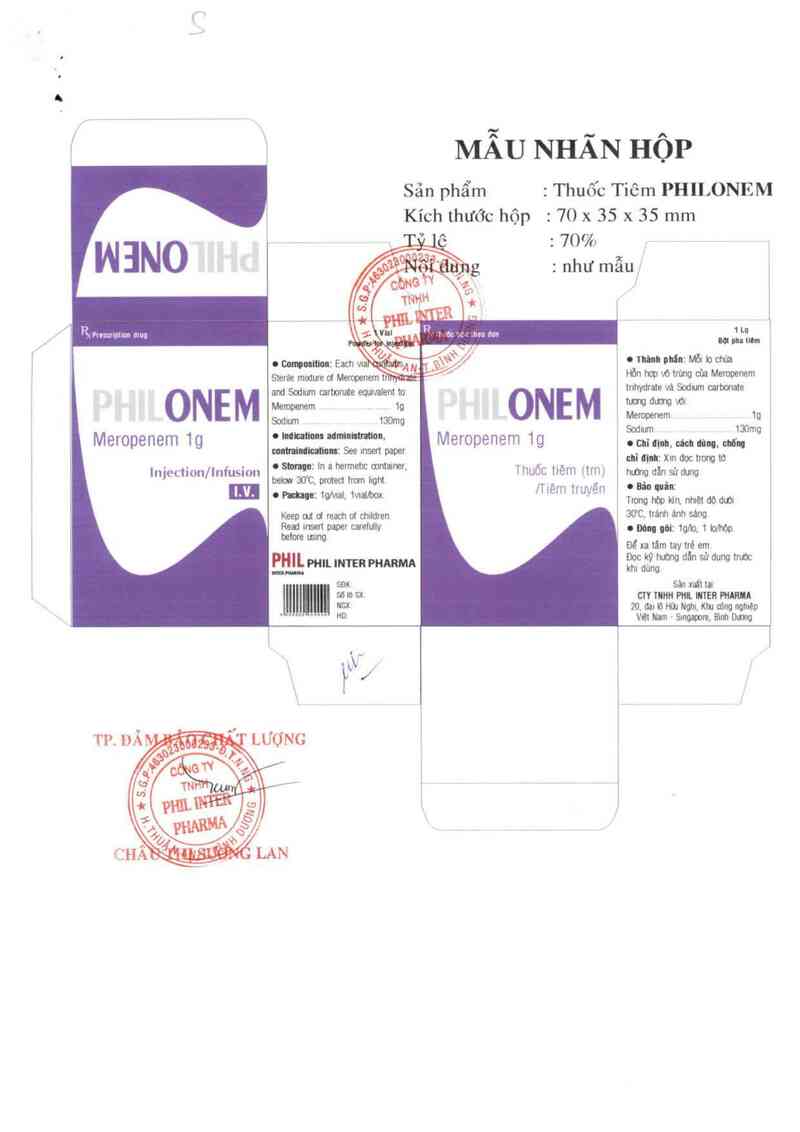
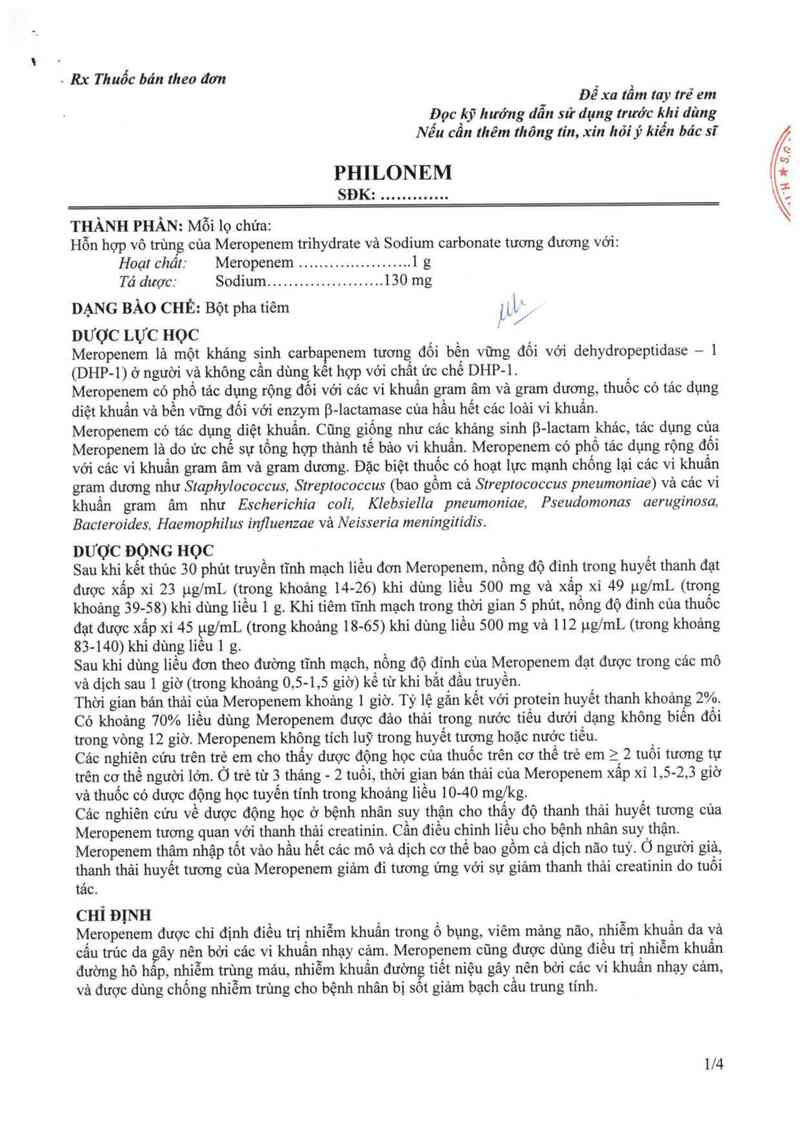
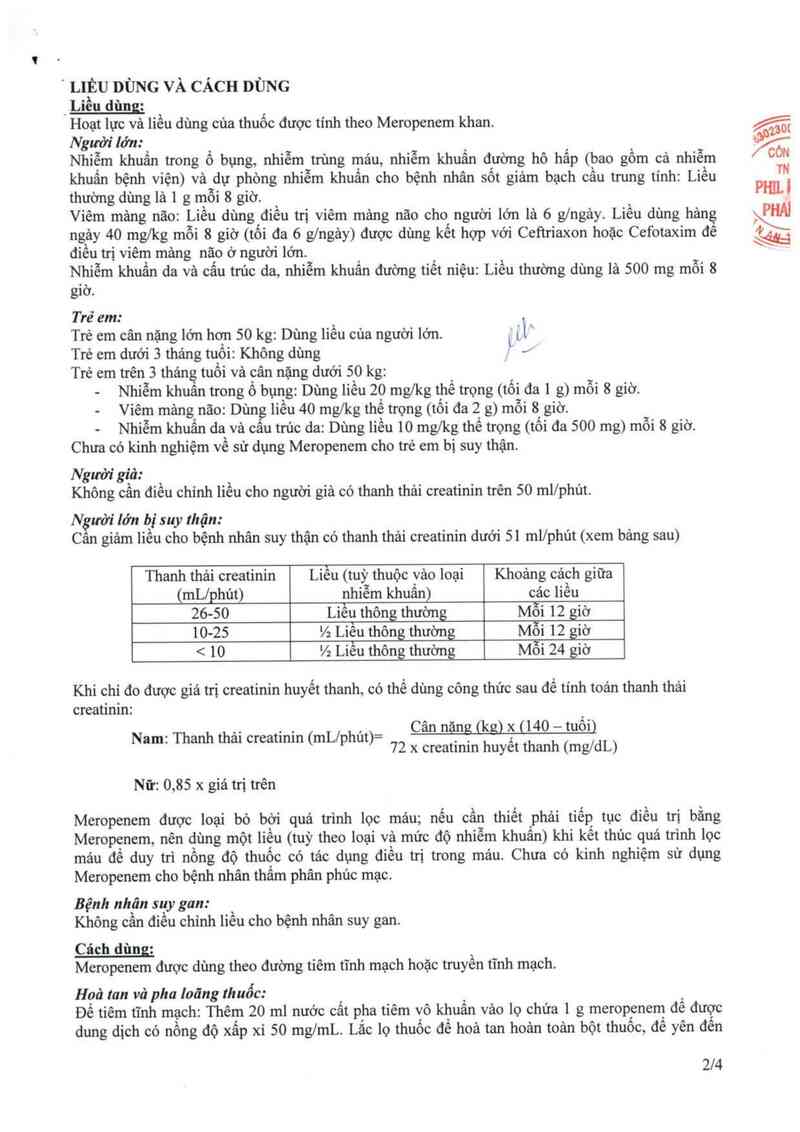
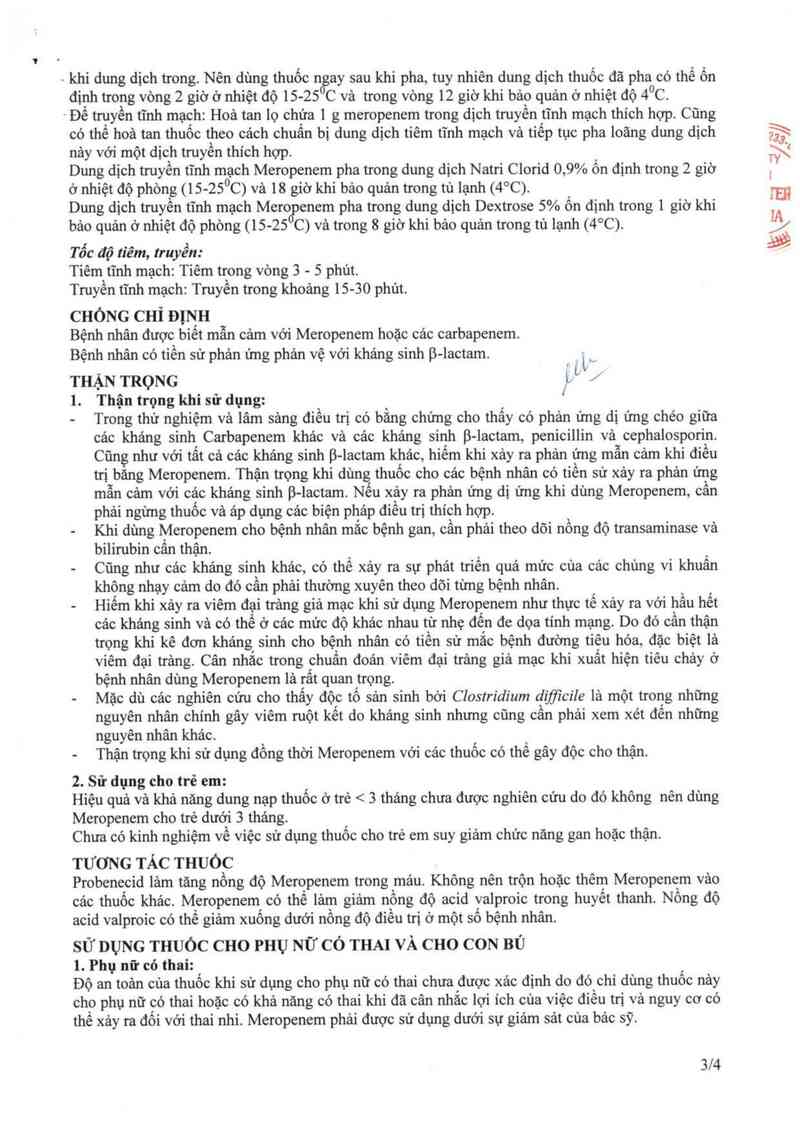
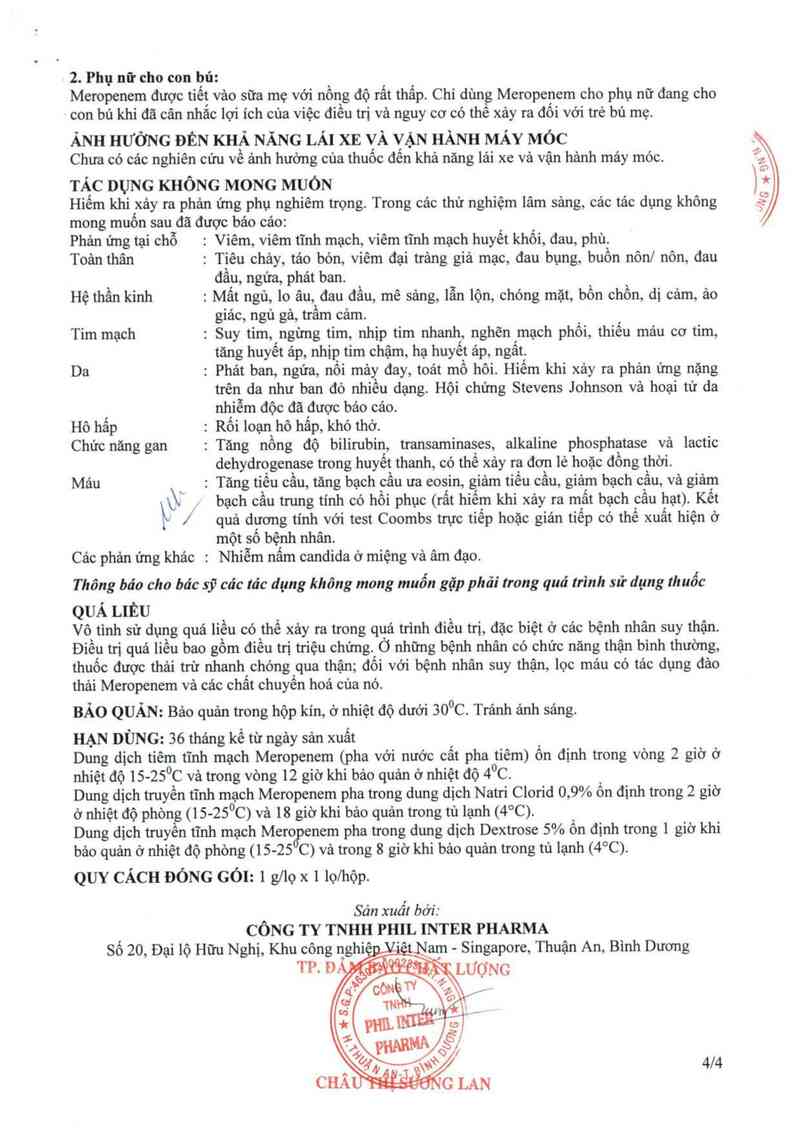
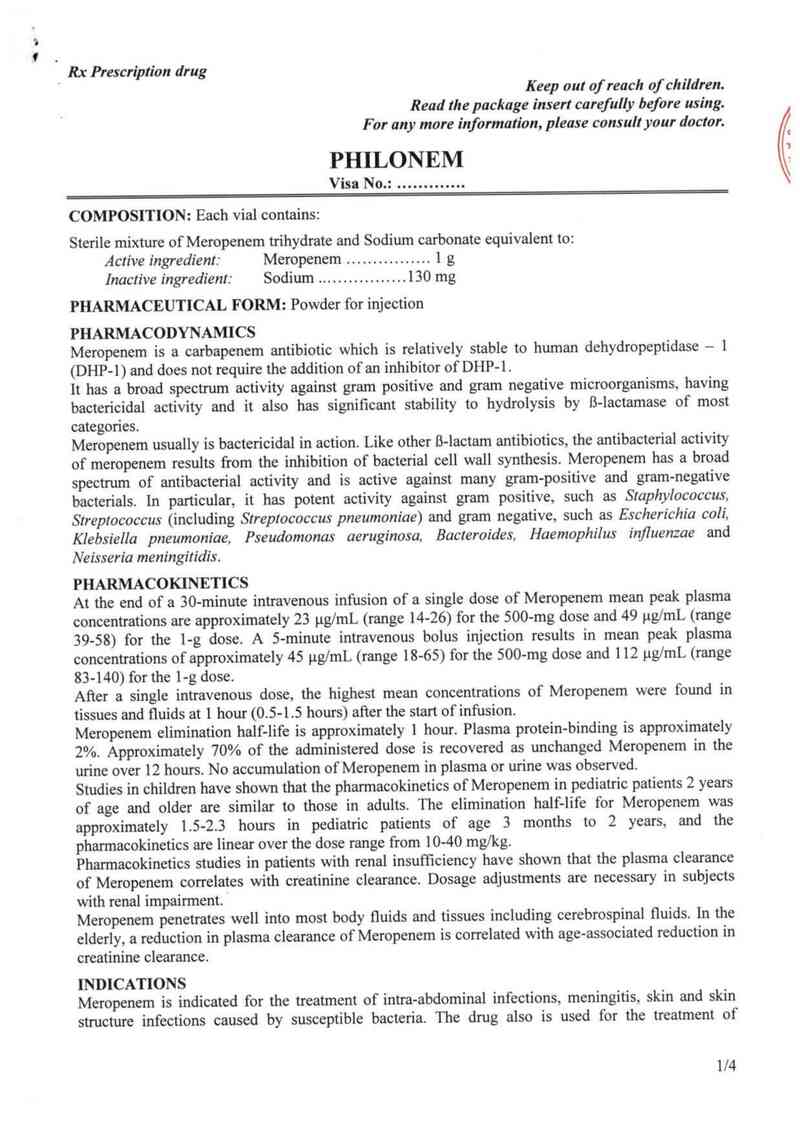
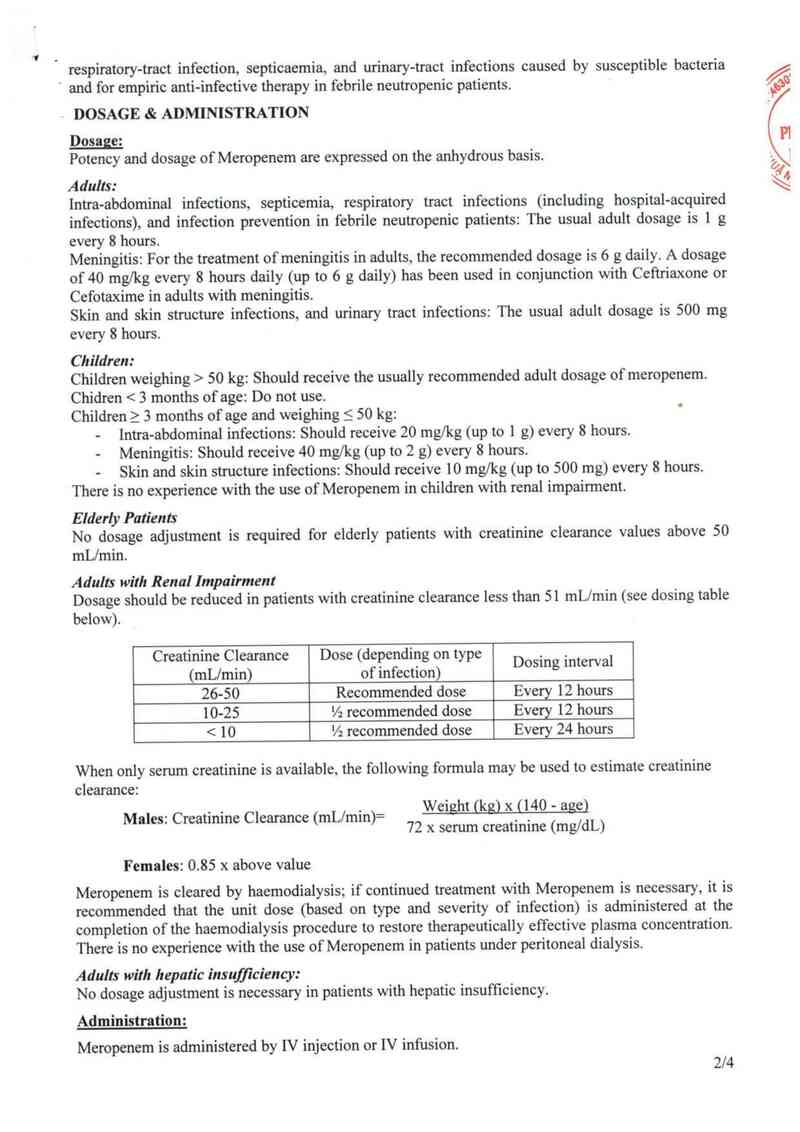
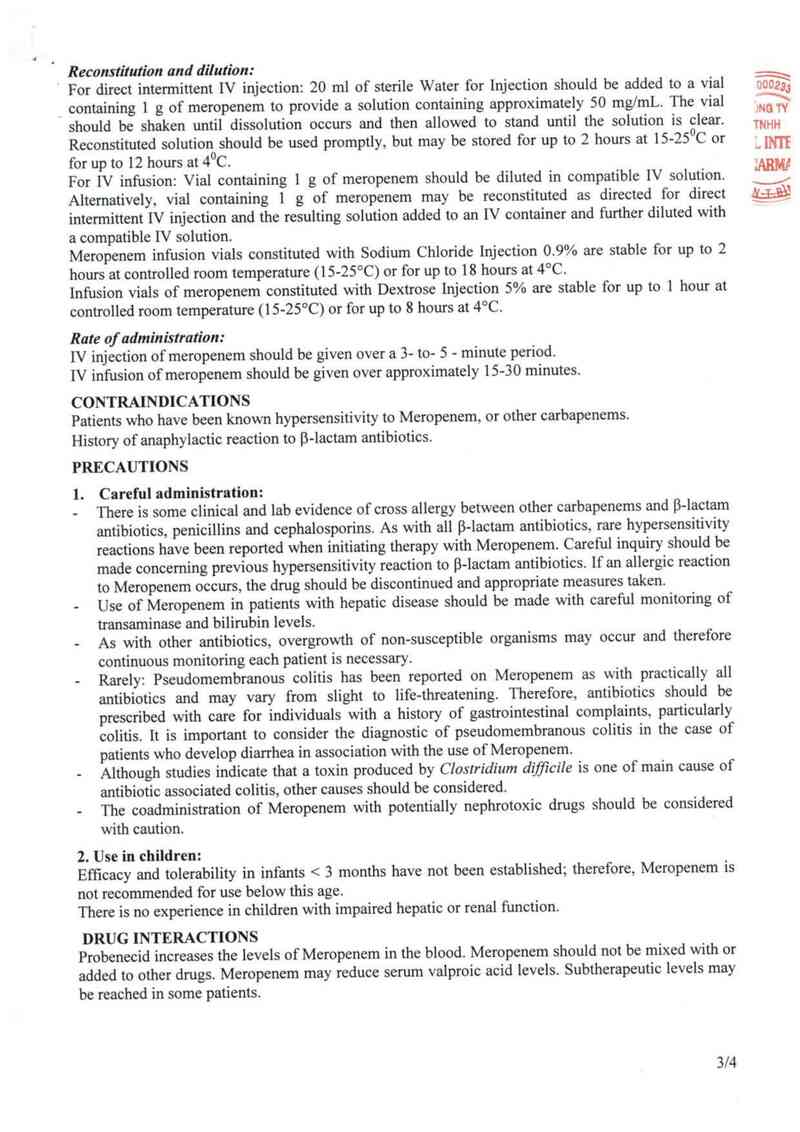
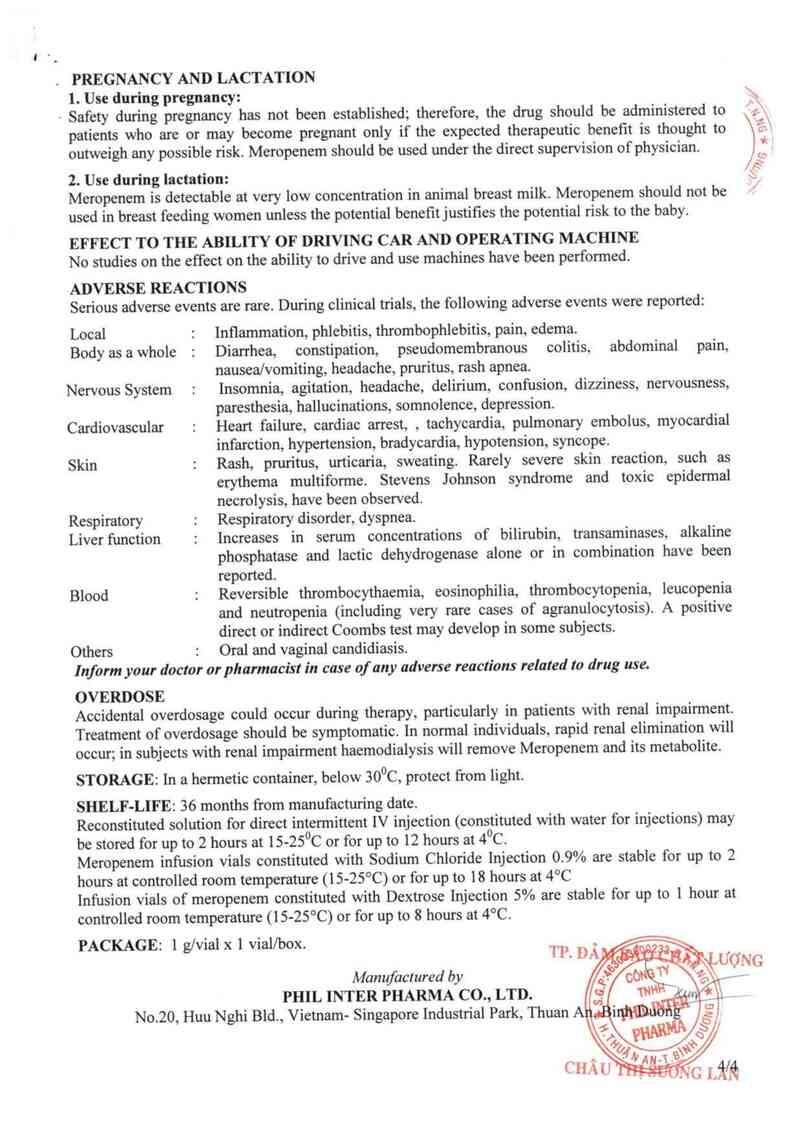
i `") MẨU NHÃN HÔP
Sản phẩm ' .Thuốc Tiêm PHILONEM
Kí th thước hộp 7:() x 35 x 35 mm
’ :70%
1L0
WÚIWI
P
,/ \. Pư:crtulton mug
, ., o mu na: MBi b chia
Stenle mtxture ơ ,. '/ Hồn hm vũ tn`m cũa Mercpenem
and Sod'um mrbonaa equivalent to. tnhydrate vả SodLưn carbơtate
ONEM Memeem tq ONEM thqumgvớ
Sodum Laomg Memnem 1LL
M 1 o Lư… u…mm M 1 Sodum Laomq
eropenem g ' GTODenem 9 ocntnu.dauin,mu
mltrùltdbtm See Lnsert paper
o Wỉ In a nermeth mntatner.
betow 30°C. pmted trom quht
N c …: 1Wal. tvLatlbox
Keep u! d madt ot children
Reat Lnsen paper caetully
betote Lsan
. cilđìlt:deoctrotìutù
Thuộc tiêm (_trn) hưmdănsửqu
[Tiêm truyền °m'l'lim
Tmno nm nm nnetdom
30°C, tránh ánhsáng
00h; lút: tq/b, 1 blMo
Đế xa tâm tay trẻ em
Đoc kỹ an dẫn sử dung tnbc
khL dùng
Injectionllnfusion
PHIL PHIL mưa PHARMA
SDK
.:;ẹxiilliffl
Sử xtãt 135
m ntttu PHI. IITER …Ninh
20. dan lb HìL Nơu, Ktu dtno nomèo
va Nam - Singapore, Binh Dưan
\
. Rx Thuốc bán theo đơn
Để xa tẩm tay trẻ em
Đọc kỹ hướng dẫn sử dụng trước khi dùng
Nếu cần thêm thông tin, xin hói ý kiến bác sĩ
PHILONEM
SĐK: .............
THÀNH PHẨN. Mỗi lọ chứa:
Hỗn hợp vô trùng cùa Meropenem trihydrate vả Sodium carbonate tương đương với:
Hoạt chất: Meropenem ...................... 1 g
Tá dược: Sodium ...................... 130 mg
DẠNG BÀO CHẾ: Bột pha tiêm Lti;
DƯỢC LỰC HỌC ’
Meropenem là một kháng sinh carbapenem tương đối bến vững đối với dehydropeptidase — l
(DHP- 1) ở người và không cần dùng kêt hợp với chất ức chế DHP- l.
Meropenem có phố tác dụng rộng đối với cảc vi khuấn gram âm và gram dương, thuốc có tảo dụng
diệt khuẩn và bền vững đối với enzym B- lactamase cùa hầu hết các loải vi khuẩn.
Meropenem có tác dụng diệt khuẩn. Cũng giống như các khảng sinh [3- lactam khảo, tảo dụng cùa
Meropenem là do ức chế sự tổng hợp thảnh tế bảo vi khuấn. Meropenem có phổ tảo dụng rộng đối
với cảc vi khuẩn gram âm và gram dương. Đặc biệt thuốc có hoạt lực mạnh ohống lại các vi khuấn
gram dương như Staphylococcus, Streptococcus (bao gồm cả Streptococcus pneumoniae) và các vi
khuấn gram âm như Escherichia coli Klebsiella pneumoníae, Pseudomonas aeruginosa,
Bacteroides, Haemophilus injluenzae vả Neisseria meningitidis.
DƯỢC ĐỘNG HỌC
Sau khi kết thúc 30 phủt truyền tĩnh mạch liều đơn Meropenem, nồng độ đinh trong huyết thanh đạt
được xấp xỉ 23 uglmL (trong khoảng 14—26) khi dùng liếu 500 mg vả xấp xỉ 49 ụg/mL (trong
khoảng 39- 58) khi dùng liều 1 g. Khi tiêm tĩnh mạch trong thời gỉan 5 phủt, nông độ đinh của thuốc
đạt được xấp xỉ 45 g/mL (trong khoảng 18— 65) khi dùng liều 500 mg và 112 ug/mL (trong khoảng
83— —140) khi dùng lieu 1 g.
Sau khi dùng liều đơn theo đường tĩnh mạch, nồng độ đỉnh cùa Meropenem đạt được trong các mô
và dịch sau 1 giờ (trong khoảng 0,5- 1,5 giờ) kế từ khi bắt đầu truyền.
Thời gian bản thải cùa Meropenem khoảng 1 giờ. Tỷ lệ gắn kết với protein huyết thanh khoảng 2%.
Có khoảng 70% liều dùng Meropenem được đảo thải trong nước tiểu dưới dạng không biến đổi
trong vòng 12 giờ. Meropenem không tích luỹ trong huyết tượng hoặc nước tiếu
Các nghiên cứu trên trẻ em cho thấy dược động học cùa thuốc trên cơ thể trẻ em > 2 tuổi tương tự
trên cơ thể người lớn. Ở trẻ từ 3 tháng- 2 tuổi, thời gian bản thải cùa Meropenem xấp xỉ 1 ,-5 2, 3 giờ
và thuốc có dược động học tuyến tính trong khoảng liều 10-40 mg/kg.
Các nghiên cứu vê dược động học ở bệnh nhân suy thận cho thấy độ thanh thải huyết tương của
Meropenem tương quan với thanh thải creatinin. Cần điều chỉnh liều oho bệnh nhân suy thận.
Meropenem thâm nhập tốt vảo hầu hết cảc mô và dịch cơ thể bao gồm cả dịch não tuỳ. Ở người giả,
thanh thải huyết tương của Meropenem giảm đi tương ứng với sự giảm thanh thải creatinin do tuổi
tảo.
CHỈ ĐỊNH
Meropenem được chỉ định điếu tn nhiễm khuẩn trong ổ bụng, viêm mảng nảo, nhiễm khuấn da và
câu trúc da gây nên bới các vi khuấn nhạy cảm. Meropenem cũng được dùng điếu trị nhiễm khuấn
đường hô hâp, nhiễm trùng máu, nhiễm khuấn đường tiết niệu gây nên bởi các vi khuẩn nhạy cảm,
và được dùng chống nhiễm trùng cho bệnh nhân bị sot giảm bạoh câu trung tính.
1/4
' LIÊU DÙNG VÀ CÁCH DÙNG
_ Liều dùng:
Hoạt lực và liều dùng cùa thuốc được tính theo Meropenem khan.
Người Iởn:
Nhiễm khuẩn trong ổ bụng, nhiễm trùng mảu, nhiễm khuấn đường hô hấp (bao gồm cả nhiễm
khuần bệnh viện) và dự phòng nhiễm khuẩn cho bệnh nhân sốt giảm bạch câu trung tính: Liều
thường dùng là 1 g mỗi 8 giờ.
Viêm mảng năo: Liều dùng điều trị viêm mảng não cho người lớn là 6 g/ngảy. Liều dùng hản
ngảy 40 mg/kg mỗi 8 giờ (tối da 6 g/ngảy) được dùng kết hợp với Ceftriaxon hoặc Cefotaxim đe
điều trị viêm mảng năo ở người lớn.
Nhiễm khuẩn da và cấu trúc da, nhiễm khuẩn đường tiết niệu: Liều thường dùng là 500 mg mỗi 8
giờ.
Trẻ em:
Trẻ em cân nặng lớn hơn 50 kg: Dùng liều cùa người lớn. ' Li
Trẻ em dưới 3 thảng tuổi: Không dùng i J
Trẻ em trên 3 thảng tuồi và cân nặng dưới 50 kg:
- Nhiễm khuân trong ổ bụng: Dùng liều 20 mg/kg thể trọng (tối đa 1 g) mỗi 8 giờ.
- Viêm mảng não: Dùng liều 40 mg/kg thể trọng (tối đa 2 g) mỗi 8 giờ.
- Nhiễm khuẩn da và oâu trúc da: Dùng liều 10 mg/kg thể trọng (tối đa 500 mg) mỗi 8 giờ.
Chưa có kinh nghiệm về sử dụng Meropenem cho trẻ em bị suy thận.
Người giă:
Không cân điều chinh liều cho người giả có thanh thải creatinin trên 50 ml/phút.
N ười lớn bị suy thận:
Can giảm liều cho bệnh nhân suy thận có thanh thải creatinin dưới 51 mi/phủt (xem bảng sau)
Thanh thải creatinin Liều (tuỳ thuộc vảo Ioại Khoảng cảch giữa
(mL/phút) nhiễm khuẩn) cảo liều
26-50 Liễu thông thường Mỗi 12 giờ
10-2s V2 Liều thông thường Mỗi 12 giờ
< 10 l/z Liều thông thường Mỗi 24 giờ
Khi chỉ đo được giá trị creatinin huyết thanh, có thể dùng công thức sau để tính toản thanh thải
creatinin:
. . . , Cân năng (kg) x (140 - tuổi)
: anh ả L L/ t = ,
Nam Th th ' ma …… (m phu ) 72 x creatinin huyêt thanh (mg/dL)
Nữ: 0,85 x giá trị trên
Meropenem được loại bỏ bời quá trình lọc máu, nếu cần thiết phải tiếp tục điều trị bằng
Meropenem, nên dùng một liều (tuỳ theo loại vả mức độ nhiễm khuẩn) khi kết thúc quá trình lọc
máu dế duy tri nổng độ thuốc có tảo dụng điều trị trong mảu. Chưa có kinh nghiệm sử dụng
Meropenem cho bệnh nhân thầm phân phủc mạc.
Bệnh nhân suy gan:
Không cần điều chỉnh liều cho bệnh nhân suy gan.
Cách dùng: \
Meropenem được dùng theo đường tiêm tĩnh mạch hoặc truyên tĩnh mạch.
Hoả Ian vã pha Ioãng thuốc:
Đế tiêm tĩnh mạch: Thêm 20 ml nước cất pha tiêm vô khuấn vảo lọ chứa 1 g meropenem đế được
dung dịch có nồng độ xấp xỉ 50 mg/mL. Lắc lọ thuốc để hoả tan hoản toản bột thuốc, để yên đến
2/4
’t7ăẫả
- khi dung dịch trong. Nên dùng thuốcn ntgay sau khi pha, tuy nhiên dung dịch thuốc đã pha0 có thế ỏn
định trong vòng 2 giờ ở nhiệt độ 15- 25 C và trong vòng 12 giờ khi bảo quản ở nhiệt độ 40 C
-Đế truyền tĩnh mạch: Hoả tan lọ chứa 1 g meropenem trong dịch truyền tĩnh mạch thích hợp. Cũng
có thể hoá tan thuốc theo cách chuẩn bị dung dịch tiêm tĩnh mạch vả tiếp tục pha loãng dung dịch
nảy với một dịch truyền thích hợp.
Dung dịch truyền tĩnh mạch Meropenem pha trong dung dịch Natri Clorid 0,9% on định trong 2 giờ
ở nhiệt độ phòng (15- 25°C) và 18 giờ khi bảo quản trong tủ lạnh (4°C).
Dung dịch truyền tĩnh mạch Mem oopenem pha trong dung dịch Dextrose 5% ỏn định trong 1 giờ khi
bảo quản ở nhiệt độ phòng (15 -25 C) va trong 8 giờ khi bảo quản trong tủ lạnh (4°C).
T oc độ tỉêm, truyền:
Tiêm tĩnh mạch: Tiêm trong vòng 3 - 5 phút.
Truyền tĩnh mạch: Truyền trong khoảng 15-30 phút.
CHỐNG CHỈ ĐLNLL
Bệnh nhân được biêt mẫn cảm với Meropenem hoặc các carbapenem.
Bệnh nhân có tiền sử phản ứng phản vệ với kháng sinh LL…Lactam.
THẶN TRỌNG
]. Thận trọng khi sử dụng:
- Trong thử nghiệm và lâm sảng điều trị có bằng chứng cho thấy có phản ứng dị ứng chéo giữa
cảc khảng sinh Carbapenem khác và các kháng sinh [3— —lactam, penicillin vả cephalosporin.
Cũng như với tất cả cảc khảng sinh [3- -lactam khảo, hiếm khi xảy ra phản ứng mẫn cảm khi điều
trị băng Meropenem. Thận trọng khi dùng thuốc cho oác bệnh nhân có tiền sử xảy ra phản ứng
mẫn cảm với cảc khảng sinh [3- -lactam. Nếu xảy ra phản ứng dị ứng khi dùng Meropenem, cân
phải ngừng thước và ảp dụng cảc biện phảp điều trị thích hợp.
- Khi dùng Meropenem cho bệnh nhân mắc bệnh gan, cần phải theo dõi nồng độ transaminase vả
bilirubin cân thận.
- Cũng như oảo kháng sinh khác, có thể xảy ra sự phát triến quá mức của cảc chủng vi khuẩn
khộng nhạy cảm do đó cần phải thường xuyên theo dõi từng bệnh nhân.
- Hiếm khi xảy ra viêm đại trảng giả mạo khi sử dụng Meropenem như thực tế xảy ra với hầu hết
cảo kháng sinh và có thế ở cảc mức độ khác nhau từ nhẹ đến đe dọa tính mạng. Do dó cần thận
trọng khi kê đơn kháng sinh oho bệnh nhân có tiến sứ mắc bệnh đường tiệu hóa, đặc biệt là
viêm đại trảng. Cân nhắc trong chuẩn đoản viêm đại trảng giả mạo khi xuất hiện tiêu chảy ở
bệnh nhân dùng Meropenem là rất quan trọng.
- Mặc dù cảc nghiên cứu cho thấy độc tố sản sinh bới Clostridium difficile là một trong những
nguyên nhân chính gây viêm ruột kết do kháng sinh nhưng cũng cân phải xem xét đến những
nguyên nhân khảo.
— Thận trọng khi sử dụng đồng thời Meropenem với các thuốc có thể gây độc cho thận.
Lửị
2. Sử dụng oho trẻ em:
Hiệu quả và khả năng dung nạp thuốc ở trẻ < 3 tháng chưa được nghiên cứu do đó không nên dùng
Meropenem cho trẻ dưới 3 thảng.
Chưa có kinh nghiệm về việc sử dụng thuốc cho trẻ em suy giảm chức năng gan hoặc thận
TƯO'NG TÁC THUỐC
Probenecid lảm tăng nồng độ Meropenem trong mảu. Không nên trộn hoặc thêm Meropenem vảo
cảc thuốc khảo. Meropenem có thể lảm giảm nồng độ acid vaiproic trong huyết thanh. Nồng độ
acid valproic có thể giảm xuống dưới nồng độ điều trị ở một sô bệnh nhân.
sử DỤNG THUỐC CHO PHỤ NỮ cớ THAI VÀ cưo CON BÚ
]. Phụ nữ có thai:
Độ an toản của thuốc khi sử dụng cho phụ nữ có thai chưa được xảo định do đó chỉ dùng thuốc nảy
cho phụ nữ có thai hoặc có khả năng có thai khi đã cân nhắc lợi ích của việc điều trị và nguy cơ có
thể xảy ra đối với thai nhi. Meropenem phải được sử dụng dưới sự giảm sảt của bác sỹ.
3/4
,ẵ//
Ề\ỉ @ “ ²/.
2. Phụ nữ cho con bủ:
Meropenem được tiết vảo sữa mẹ với nồng độ rất thấp. Chỉ dùng Meropenem cho phụ nữ đang cho
con bú khi đã cân nhắc lợi ích của việc điều trị và nguy cơ có thể xảy ra đổi với trẻ bú mẹ.
ẢNH HƯỞNG ĐẾN KHẢ NĂNG LÁ! XE VÀ vẶN HÀNH MÁY MÓC
Chưa có các nghiên cứu về ảnh hướng cùa thuốc đên khả năng lải xe và vận hảnh mảy móc.
TÁC DỤNG KHÔNG MONG MUÔN
Hiêm khi xảy ra phản ứng phụ nghiêm trọng. Trong cảc thử nghiệm lâm sảng, cảc tảo dụng không
mong muốn sau đã được bảo cảo:
Phản ứng tại chỗ : Viêm, viêm tĩnh mạch, viêm tĩnh mạch huyết khối, đau, phù.
Toản thân : Tiêu chảy, tảo bón, viêm đại trảng giả mạc, đau bụng, buồn nôn/ nôn, đau
đầu, ngứa, phảt ban.
Hệ thần kinh : Mất ngủ, lo âu, đau đầu, mê sảng, lẫn lộn, chóng mặt, bồn chổn, dị cảm, ảo
giác, ngủ gả, trầm cảm.
Tim mạch : Suy tim, ngừng tim, nhịp tim nhanh, nghẽn mạch phối, thiếu mảu cơ tim,
tăng huyết' ap, nhịp tim chậm, hạ huyết ảp, ngất,
Da : Phát ban, ngứa, nôi mảy đay, toát mô hôi. Hiếm khi xảy ra phản ứng nặng
trên da như ban đó nhiều dạng. Hội chứng Stevens Johnson và hoại tử da
nhiễm độc đã được bảo cáo.
Hô hấp : Rối loạn hô hấp, khó thớ.
Chức năng gan : Tăng nồng độ bilirubin, transaminases, a1kaline phosphatase vả lactic
dehydrogenase trong huyết thanh, có thể xảy ra đơn lẻ hoặc đồng thời.
Mảu : Tăng tiếu câu, tăng bạch câu ưa eosin, giảm tiểu cầu, giảm bạch cầu, và giảm
ỒỈ _ bạch cầu trung tính có hồi phục (rất hiếm khi xảy ra mất bạch cầu hạt). Kết
: quả dương tính với test Coombs trực tiếp hoặc gián tiếp có thể xuất hiện ở
một sô bệnh nhân.
Các phản ứng khảo : Nhiễm nấm candida ở miệng vả âm đạo.
T hông báo cho bác sỹ cảc tác dụng không mong muốn gặp phải trong quá trình sử dụng thuốc
QUẢ LIÊU
Vô tình sử dụng quá liều có thể xảy ra trong quá trình điều trị, đặc biệt ở các bệnh nhân suy thận.
Điều trị quá liều bao gồm điều trị triệu chứng Ở những bệnh nhân có chức năng thận bình thường,
thuốc được thải trừ nhanh chóng qua thận; đối với bệnh nhân suy thận, lọc mảu có tảo dụng đảo
thải Meropenem vả cảc chất chuyến hoả cùa nó
BÁO QUÁN: Bảo quản trong hộp kín, ở nhiệt độ dưới 30°C. Trảnh ánh sảng.
HẠN DÙNG: 36 tháng kể từ ngảy sản xuất
Dung dịch tiêm tĩnh mạch Meropenem (pha với nước cất pha otiếm) ổn định trong vòng 2 giờ ở
nhiệt độ 15- 25 OC và trong vòng 12 giờ khi bảo quản ở nhiệt độ 40 C.
Dung dịch truyền tĩnh mạch Meropenem pha trong dung dịch Natri Clorid 0,9% ớn định trong 2 giờ
ở nhiệt độ phòng (15- 25°C) và 18 giờ khi bảo quản trong tủ lạnh (4°C).
Dung dịch truyền tĩnh mạch Mero oopenem pha trong dung dịch Dextrose 5% òn định trong 1 giờ khi
bảo quản ở nhiệt độ phòng (15- 25 C) va trong 8 giờ khi bảo quản trong tủ 1ạnh (4°C).
QUY CÁCH ĐÓNG GÓI: 1 g/1ọ x L lọ/hộp.
Sản xuất bởi.
CÔNG TY TNHH PHIL INTER PHARMA
…
0 .
'. Rx Prescription drug
Keep out ofreach ofchildren.
Read the package ìnsert carefully before using.
F or any more information, please consult your doctor.
PHILONEM
Visa No.: .............
COMPOSITION: Each via! contains:
Sterile mixture of Meropenem trihydrate and Sodium carbonate equivalent to:
Active ingredient: Meropenem ................ 1 g
Inactive ingredient: Sodium ................. 130 mg
PHARMACEUTICAL FORM: Powder for injection
PHARMACODYNAMICS
Meropenem is a carbapenem antibiotic which is relativer stable to human dehydropeptidase — l
(DHP-l) and does not require the addition of an inhibìtor of DHP-l.
It has a broad spectrum activity against gram positive and gram negative microorganisms, having
bactericidal activity and it also has significant stability to hydroiysis by B-lactamase of most
categories.
Meropenem usually is bactericidal in action. Like other B-laotam antibiotics, the antibacterial activity
of meropenem results from the inhibition of bacterial cell wall synthesis. Meropenem has a broad
spectrum of antibacterial activity and is active against many gram-positive and gram-negative
bacterials. In particular, it has potent activity against gram positive, such as Slaphylococcus,
Streplococcus (including Streptococcus pneumoniae) and gram negative, such as Escherichia coli,
Klebsiella pneumoniae, Pseudomonas aeruginosa, Bacteroides, Haemophilus influenzae and
Neisseria meningitidís.
PHARMACOKINETICS
At the end of a 30-minute intravenous infusion of a single dose of Meropenem mean peak plasma
concentrations are approximately 23 ug/mL (range 14-26) for the 500-mg dose and 49 LLg/mL (range
39-58) for the l-g dose. A 5-minutc intravenous bolus injection results in mean peak plasma
concentrations of approximately 45 LLg/mL (range 18-65) for the 500-mg dose and 112 LLg/mL (range
83-140) for the 1-g dose.
After a single intravenous dose, the highest mean concentrations of Meropenem were found in
tỉssues and fiuids at 1 hour (0.5-1.5 hours) after the start of infusion.
Meropenem climination half-life is approximately 1 hour. Plasma protein-binding is approximately
2%. Approximately 70% of the administered dose is recovered as unchanged Meropenem in the
urine over 12 hours. No accumulation of Meropenem in plasma or urine was observed.
Studies in children have shown that the pharmacokinetics of Meropenem in pediatric patients 2 years
of age and older are similar to those in adults. Tho elimination half-life for Meropenem was
approximately 1.5-2.3 hours in pediatric patients of age 3 months to 2 years, and the
phannacokinetics are linear over the dose range from 10-40 mg/kg.
Pharmacokinetics studies in patients with renal insufficiency have shown that the plasma ciearance
of Meropenem correlates with creatinine clearance. Dosage adjustments are necessary in subjects
with renal impairment.
Meropenem penetrates well into most body f1uids and tissues including cerebrospinal fiuids. In the
elderly, a reduction in plasma clearance of Meropenem is correlated with age—associated reduction in
creatinine clearance.
INDICATIONS
Mcropcnem is indicated for the treatment of intra-abdominal infections, meningitis, skin and skin
structure infections caused by susceptible bacteria. The drug also is used for the treatment of
1/4
...Aa
' respiratory-tract infection, septicaemia, and urinary-tract infections caused by susceptible bacteria
' and for empiric anti-infective therapy in febrile neutropenic patients.
DOSAGE & ADMINISTRATION
Dosage:
Potency and dosage of Meropenem are expressed on the anhydrous basis.
Adults:
Intra-abdominal infections, septicemia, respiratory tract infections (including hospital-acquired
infections), and infection prevention in febrile neutropenic patients: The usual adult dosage is 1 g
every 8 hours.
Meningitis: For the treatment of meningitis in adults, the recommended dosage is 6 g daily. A dosage
of 40 mg/kg every 8 hours daily (up to 6 g daily) has been used in conjunction with Ceftriaxone or
Cefotaxime in adults with meningitis.
Skin and skin structure infections, and urinary tract infections: The usual adult dosage is 500 mg
every 8 hours.
Children:
Children weighing > 50 kg: Should receive the usually recommended adult dosage of meropenem.
Chidren < 3 months of age: Do not ưse.
Children ì 3 months of age and weighing S 50 kg:
- Intra-abdominal infections: Should receive 20 mg/kg (up to 1 g) every 8 hours.
- Meningitis: Should receive 40 mg/kg (up to 2 g) every 8 hours.
- Skin and skin structure infections: Should receive 10 mg/kg (up to 500 mg) every 8 hours.
There is no experience with the use of Meropenem in childxen with renal impairment.
Elderly Patients
No dosage adjustment is required for elderly patients with creatinine clearance values above 50
mL/min.
Adults with Rena! Impairment
Dosage should be reduced in patients with creatinine clearance less than 51 mL/min (see dosing table
below).
Creatinine Clearance Dose (de endin ont e . .
(mL/min) of ihfectiằn) YP Dosmg mterval
26-50 Recommended dose Every 12 hours
10-25 % recommended dose Every 12 hours
< 10 ’/z recommended dose Every 24 hours
When only semm creatinine is available, the following formula may be used to estimate creatinine
clearance:
Weightịkgịx {140 - age)
Males: Creatinỉne Clearance (mL/min)= 72 x serum creatinine (m gl dL)
Females: 0.85 x above value
Meropenem is cleared by haemodialysis; if continued treatment with Meropenem is necessary, it is
recommended that the unit dose (based on type and severity of infection) is administered at the
oompletion of the haemodialysis procedure to restore therapeutically effective plasma concentration.
There is no experience with the use of Meropenem in patients under peritoneal dialysis.
Adults with hepatic insufflciency:
No dosage adjustment is necessary in patients with hepatic insuftìciency.
Administration:
Meropenem is administered by IV injection or IV infusion.
2/4
' Reconstitutỉon and dilution:
For direct ìntermittent IV injection: 20 ml of sterile Water for Injection should be added to a vial
_ containing 1 g of meropenem to provide a solution oontaining approximately 50 mg/mL. The via]
should be shaken until dissolution occurs and then allowed to stand until the solution is clear.
Reconstituted solution should be used promptly, but may be stored for up to 2 hours at 15-250C or
for up to 12 hours at 40C.
For IV infusion: Vial containing 1 g of meropenem should be diluted in compatible IV solution.
Altematively, vial containing 1 g of meropenem may be reconstituted as directed for direct
intermittent IV injection and the resulting solution added to an IV container and further diluted with
a compatible IV solution.
Meropenem infusion vials constìtuted with Sodium Chloride Injection 0.9% are stable for up to 2
hours at controlled room temperature (15-25°C) or for up to 18 hours at 4°C.
Infusion vials of meropenem constìtuted with Dextrose Injection 5% are stable for up to 1 hour at
controlled room temperattưe (15-25°C) or for up to 8 hours at 4°C .
Rate ofadmim'stration:
IV injection of meropenem should be given over a 3- to- 5 - minute period.
IV infusion of meropenem should be given over approximately 15-30 minutes.
CONTRAINDICATIONS
Patients who have been known hypersensitivity to Meropenem, or other carbapenems.
History of anaphylactic reaction to B—lactam antibiotics.
PRECAUTIONS
]. Carefuladministration:
- There is some clinical and lab evidence of cross allergy between other carbapenems and B—lactam
antibiotics, penicillins and cephalosporins. As with all B-lactam antibiotics, rare hypersensitivity
reaotions have been reported when initiating therapy with Meropenem. Careful inquiry should be
made oonceming previous hypersensitivity reaction to B-lactam antibiotics. If an allergic reaction
to Meropenem occurs, the drug should be discontinued and appropriate measures taken.
— Use of Meropenem in patients with hepatic disease should be made with careful monitoring of
transaminase and bilirubin levels.
— As with other antibiotics, overgrowth of non—susoeptible organisms may occur and therefore
continuous monitoring each patient is necessary.
- Rarely: Pseudomembranous colitis has been reported on Meropenem as with practically all
antibiotics and may vary from slight to life-threatening. Therefore, antibiotics should be
prescribed with oare for individuals with a history of gastrointestinal complaints, particularly
colitis. It is important to consider the diagnostic of pseudomembranous oolitis in the case of
patients who develop diarrhea in association with the use of Meropenem.
- Although studies indicate that a toxin produced by Clostridium difflcile is one of main cause of
antibiotic associated colitis, other causes should be considered.
- The ooadministration of Meropenem with potentially nephrotoxic drugs should be considered
with caution.
2. Use in children:
Efftcacy and tolerability in infants < 3 months have not been established; therefore, Meropenem is
not recommended for use below this age.
There is no experience in children with impaired hepatic or renal function.
DRUG INTERACTIONS
Probenecid increases the levels of Meropenem in the blood. Meropenem should not be mixed with or
added to other drugs. Meropenem may reduce semm valproic acid levels. Subtherapeutic levels may
be reached in some patients.
3/4
. PREGNANCY AND LACTATION
l. Use during pregnancy:
. Safety during pregnancy has not been established; therefore, the drug should be administered to
patients who are or may become pregnant only if the expected therapeutic benefìt is thought to
outweigh any possible risk. Meropenem should be used under the direct supervision of physician.
2. Use during lactation:
Meropenem is detectabie at very low concentration in animal breast milk. Meropenem should not be
used in breast fceding women unless the potential benefit justiftes the potential risk to the baby.
EFFECT TO THE ABILITY OF DRIVING CAR AND OPERATING MACHINE
No studies on the etĩect on the ability to drive and use machines have been performed.
ADVERSE REACTIONS
Serious adverse events are rate. During clinical trials, the following adverse events were reported:
Local : Infiammation, phlebitis, thrombophlebitis, pain, edema.
Bodyasawhole : Dianhea, constipation, pseudomembranous colitis, abdominal pain,
nausea/vomiting, headache, pruritus, rash apnea.
Nervous System : Insomnia, agitation, headaohe, delirium, confusion, dizziness, ncrvousness,
paresthesia, hallucinations, somnolence, depression.
Cardiovascular : Heart failure, cardiac arrest, , tachycardia, pulmonary embolus, myocardial
infarction, hypcrtension, bradycardia, hypotension, syncope.
Skin : Rash, pruritus, urticarìa, sweating. Rarely severe skin reaction, such as
erythema multiforme. Stevens Johnson syndrome and toxic epidermal
necrolysỉs, have been observed.
Respiratory : Respiratory disorder, dyspnea.
Liver function : Inoreases in serum concentrations of bilirubin, transaminases, alkaline
phosphatase and lactic dehydrogenase alone or in combination have been
reported.
Blood : Reversible thrombocythaemia, eosinophilia, thrombocytopenia, leucopenia
and neutropenia (including very rare oases of agranuiocytosis). A positive
direct or indirect Coombs test may develop in some subjects.
Others : Oral and vaginal candidiasis.
Inform your docior or pharmacist in case ofany adverse reactions related to drug use.
OVERDOSE
Accidental overdosage could occur during therapy, particularly in patients with renal impairmcnt.
Treatment of overdosage should be symptomatic. In normal individuals, rapid renal elimination will
occur; in subjects with renal impairment haemodialysis will remove Meropenem and its metabolite.
STORAGE: In a hermetic container, below 30°C, protect from light.
SHELF-LIFE: 36 months from manufaoturing date.
Reconstituted solution for direct intermittent IV injection (constìtuted with water for injections) may
be stored for up to 2 hours at 15-250C or for up to 12 hours at 400
Meropenem infusion vials oonstituted with Sodium Chloride Injection 0.9% are stable for up to 2
hours at controlled room temperature (15-25°C) or for up to 18 hours at 4°C
Infusion vials of meropenem oonstituted with Doxtrose Injection 5% are stable for up to 1 hour at
controlled room temperature (15-25°C) or for up to 8 hours at 4°C.
PACKAGE: 1 g/vial x 1 vial/box.
Manufactured by
PHIL INTER PHARMA CO., LTD.
No.20, Huu Nghi Bld., Vietnam- Singapore Industrial Park, Thuan A
xă
li'G LLẺ)iỆ_ |
\`__/~
\_\Kf7
+ "Lưu ý những sản phẩm đăng trên website thuộc loại thực phẩm chức năng: những sản phẩm này không phải là thuốc và không có tác dụng thay thế thuốc chữa bệnh"
+ Dùng thuốc theo chỉ định của Bác sĩ
+ Đọc kỹ hướng dẫn sử dụng trước khi dùng